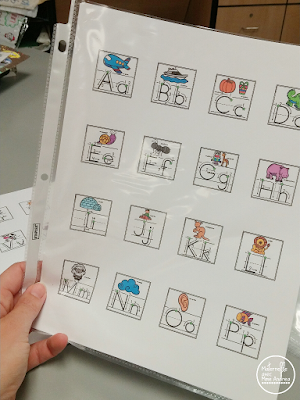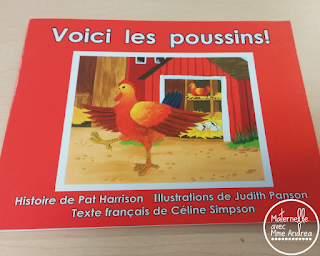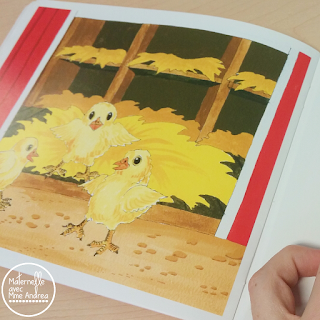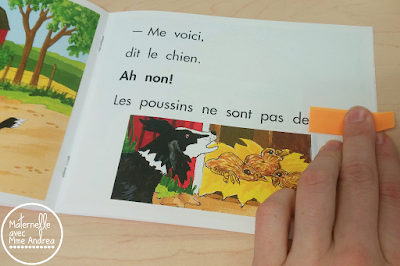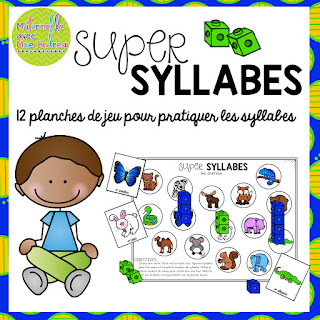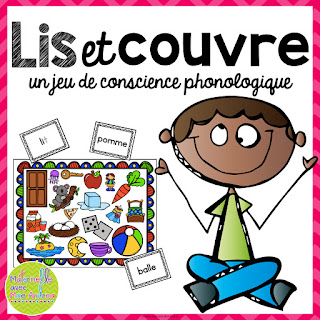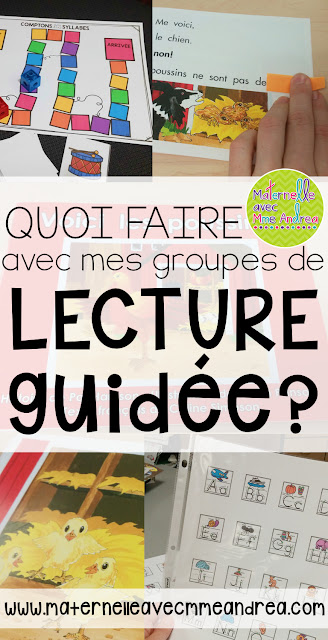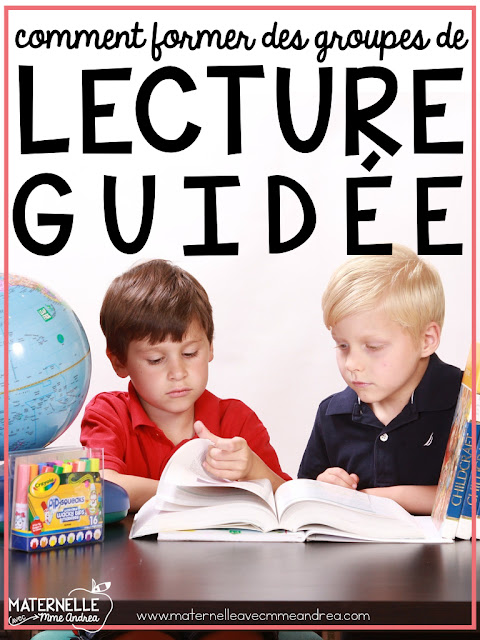Bonjour!
I have been talking a bit about what guided reading looks like in my classroom lately. Last week on my blog, I talked about how I sort my students into their guided reading groups. But once you have your groups together… what exactly should you be doing with them?!
Guided reading blocks look different in just about every classroom. As always, I feel the secret to success is finding out what works for YOU, in your classroom! On my blog, I love showing you how I do things. But, I don’t pretend for a second that I know everything! I only know what works for me – so feel free to give it a try, and adjust as needed for your own students :)
Today, I will share with you what my guided reading block looks like in my classroom, and what general activities I squeeze in with each group during that time.
I do guided reading from about 9:15-10:00am every morning. The rest of my class does centres at the same time, which really keeps me accountable – they LOVE centres and complain big-time if we miss them for anything! I do my best to see three groups per day, which only gives me about 15 minutes per group. However, if we get started late, I sometimes only get to see two groups – especially if they are reading higher-level books that are longer.
Here is our guided reading routine:
1. REVIEW
Depending on the group, we review the reading strategies we know (look at the picture, look at the first letter, etc. – you can grab the free reading strategies poster that I use here), or our alphabet chart (to make an alphabet chart, I just printed out my alphabet posters all on two pages using the multiple option in Adobe and stuffed them into a sheet protector back to back).
2. PRESENT OUR NEW BOOK
As I said last week, I prefer to have my students in the same group reading the same book as much as possible. I just find it much easier to manage! I present the cover page and we discuss what we know about that topic, make predictions, make connections, etc. If we were reading the book pictured below, I would ask them what they see in the picture and we would talk about how baby chicks hatch from eggs. Then, we do a picture walk.
Picture walks are SO IMPORTANT!! I never ask my students to read me a book without first doing a picture walk. In the beginning, I lead and model the picture walk, but later on I sometimes ask my students to lead the picture walk themselves. It is something that I want them doing independently, on their own, every time they grab a new book – not just during guided reading.
To do a picture walk, I show and we discuss each picture. I cover the words with my hands. The goal is to get students’ brains ready to read. Encourage them to verbalize the sentence structures and words that may be written on that page. Picture walks are all about verbalizing – not reading! We need their brains to be already thinking about which words will make sense. This will help prepare them to read the real words on the page after you are done the picture walk.
In this picture, we would talk about how the baby chicks are finally standing up all by themselves, and they look so happy and proud! Their mama must be so proud, too!
If there is any vocabulary your students may be unfamiliar with, a picture walk is a GREAT time to introduce it. Point it out in the picture and ask them if they know a word for it. Sometimes they will use a different word – like chaise when the book says fauteuil.
When that happens, I say something like “Oui, tu as raison! C’est une chaise! Cette chaise est très spéciale et très molle. Dans ce livre, on l’appelle un fauteuil. Peux-tu dire le mot fauteuil? Tu vas le savoir quand tu vois le mot fauteuil, parce que ce mot commence par…” and I get the student to verbalize what first letter they will be looking for to help them remember that new word.
3. WHAT I WANT TO SEE WHEN THEY ARE READING…
Before we start, I remind my students of what I want to see them do when they come across a word they don’t know.
Do we look at Madame? Nope! Do we look at the sky? Nope! So what do we do?
The answer depends on the strategies they know, but generally involves looking at something in the book ;)
If I am teaching them a new strategy, this is when I introduce it. I show them how to do it with words in the book. So, if we are new to “chunking”(lis le mot en parties avec la chenille), I will find a word or two that I want them to read in chunks for me and we practice together. Then I expect them to try reading it in chunks on their own while they are reading.
In the above picture, I showed my students how to use a strip of paper to hide the parts of the word to help with reading in chunks (the partially hidden word was debout). I then gave them each a strip of paper to use as needed. I want them to do what I teach them!
4. READ… AND RECORD!
I ask my students to find and point to the first word and then get started reading. That is a gentle little reminder that we need to remember to look at the words as we are reading. I expect my students who don’t yet have 1:1 correspondence to touch all of the words as they read, but I don’t want my students who are at level 3+ to be touching every word – just the words they are sounding out or that they find tricky. It is hard to be a fluid reader if you point at every word!!!
I usually have one student read totally independently and the other sit beside me and I will do a little running record on them while they read. I will be talking more about running records next week, but this is not a running record that I would use to level them or use for any “official” data. This running record is just a place for me, where I can write down the strategies I saw them use independently, and what reminders they needed (I am always on the lookout for reading behaviours that aren’t yet automatic that we need to work on!).
I like to do a running record and take notes on a “cold” read because the ultimate goal for me is always to have them be able to read independently. I want to see what they can do the first time they read a new book. I find these notes very valuable in guiding my future teaching, even if they aren’t submitted anywhere officially. I strongly believe that we should be reading with students every day and making notes about their reading behaviours. I often think that I know what a student will do, and find out I am wrong while doing the running record, ha! Gathering this data for 2-3 students a day helps keep me accountable and keeps my guided reading teaching relevant to each student.
5. DISCUSS AND SHARE
While I listen to one student read, I don’t allow the other to interrupt us. But, I give them some sticky notes that they can use to mark words they got stuck on. After both students are done reading, I share something great that my reader did (Ma partie préférée a été quand tu as…), especially if they made a mistake and self corrected. I always stress that when we read, it is not that we don’t want to make any mistakes. We know we are great readers when we realize that we made a mistake because what we read doesn’t make sense, and we try to fix it!
After sharing something great, we look together at the tricky words my other student marked and try to figure them out together (by together, I mean the two of them, haha… I try to sit back as much as possible and let them work it out).
6. ADD OUR NEW BOOK TO OUR READING BAGS
My students have four books in their reading bags at all times to take home for practice – three that they choose from their basket (all books that they have already seen with me and can read on their own), and one book that I choose. I take out the last book I chose for them, they put it in their basket where they can grab it the next time they change their books, and I add their new book to their reading bag.
Here is a picture of our messy book baskets!
7. A GAME!
I try to have a game that practices whatever strategy we are working on – a game for phonics, conscience phonologique, alphabet, sequencing, oral communication, blending, chunking, sound boxes, etc. These games are games that they don’t play during centres or at any other time – special games to play with me!
Here are a couple examples that you can find in my TPT store of games that I play with my students during guided reading.
They require me to be there to make sure that students are counting, blending, etc. correctly:
I have a new game my students tested for me last week for reading words in chunks that they LOVED that I will be adding to my TPT store soon! I will do a special blog post about chunking when it is uploaded.
8. STICKERS AND CLEAN UP!
I get my students to help me clean up our game and their reading bags and if they worked really hard (they always do!!!), I give them a special sticker. Then I ring the bell on my desk and we all come back to the carpet to get ready for the next round!
I hope this post is helpful to you if you are looking at starting a guided reading routine, or switching yours up! It seems like a lot to get done in 15 mins, but if you students are still reading shorter books (levels 1-3), it is more than enough time. It gets trickier as the books get longer, but I teach with a lot of urgency during guided reading and we get as much done as possible.
Guided reading is such a valuable time of our day – I really believe that it is important to make it a priority! The things you can teach your students when they are in small groups are really amazing. I would love to hear what your guided reading block looks like – please let me know in the comments!
I will be back next week to talk more about running records and when/how I do them – both during my guided reading block and how I make sure my students are reading “just right books”.
PS – Not sure how to even get started with guided reading? No problem! Enter your info below, and I will send you my FREE guided reading strategy poster & cheat sheet to help you get started!



